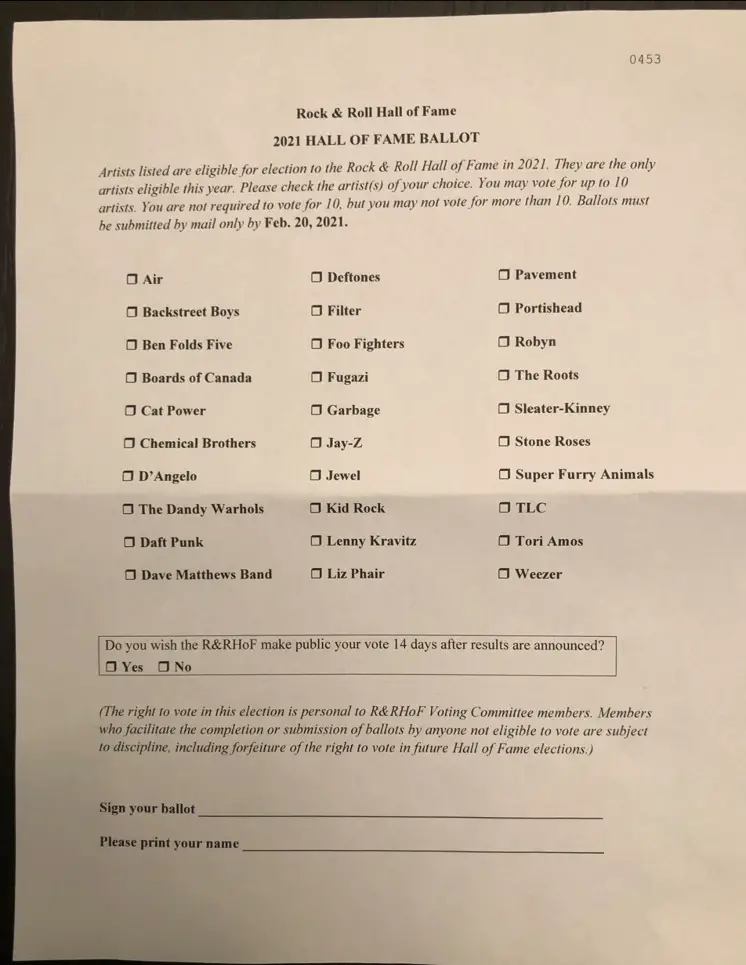Uncovering the Next Generation's Hall of Fame


On Fairness: Using the Baseball Hall of Fame Ballot as a Model for the Rock & Roll Hall of Fame

In another universe where there isn't an endless backlog, this could be the 2021 Rock Hall ballot — styled after the Baseball Hall of Fame ballot. (Illustration by Future Rock Legends)
One of the primary reasons that the Rock & Roll Hall of Fame generates so much derision from fans is that there are literally hundreds of artists who can make a Hall of Fame case, but due to the nature of the induction process, will never get a shot on the ballot. The unfairness of the system creates a visceral reaction among casual observers of the Rock Hall who simply can’t understand how legendary artists don't even get a chance after decades of eligibility. Don’t all these artists deserve an opportunity to have their names appear on a Hall of Fame ballot, ideally while they're still alive?
Compare the Rock Hall’s current system, where even once-in-a-generation artists can’t get on the ballot, with the Baseball Hall of Fame induction process where every notable player gets a shot at their first opportunity.
Some quick background: players are eligible for the Baseball Hall of Fame five years after they retire. In that first year of eligibility, a six-member Screening Committee adds every reasonable new candidate to the ballot along with all players that met a minimum 5% vote threshold from the previous year. That leads to ballots that typically have anywhere between 25 and 40 names. When the votes come in, marginal candidates quickly fall out of contention for the next year, but others are allowed up to 10 chances to get the 75% approval needed for induction before they fall off the ballot and are left for the Eras Committees to consider (formerly called the Veterans Committee).
The benefits of Baseball's system:
- Every quality candidate gets at least one chance on the ballot.
- A 10-year nomination cap provides enough time to build momentum for those who don’t get in right away, and also provides urgency for the voters when a player’s reaches their final ballot.
- Voters can vote for between 0 and 10 candidates each year, which gives voters plenty of options to give support to all those who deserve it without having to vote strategically.
- A low vote threshold to get back on the ballot allows nominees to get a multiple chances if they get caught in a stacked year.
- Players on the ballot are all from roughly the same era.
All of these attributes stand in stark contrast to the Rock Hall’s system:
- Most quality candidates never get nominated.
- There’s no nomination cap, so voters can endlessly procrastinate voting for certain artists who seem to come up every year.
- Voters are limited to selecting five artists from the ballot which leads people to vote strategically for lesser known candidates over obvious Hall of Famers, which occasionally backfires.
- While some artists get multiple chances on the ballot, many are “one and done,” even after they had never gotten a fair shot at induction because they were nominated in a strong year, or they were pitted against similar artists which split the vote.
- In any given year, voters are forced to compare artists from the 1960s to those up through the 1990s, when the context of their careers could not be more different.
- Nearly every nominated artist is Hall of Fame-worthy, making the voters choices come down to personal preference. Recently, a great induction class can be created by pulling six random artists from the ballot, since they all have their merits.
If the Rock Hall adopted a system like Baseball’s, the image at the top of this post could be the 2021 ballot, with its mix of newly eligible artists and those who have recently missed out. That fantasy ballot has many advantages over a typical Rock Hall ballot:
- Those with Hall of Fame careers clearly stand out from the rest.
- Artists with good careers get a chance at renewed exposure through their Rock Hall nomination.
- Evaluating contemporaries is much easier and a lot more fun to debate.
- It's fair to the artists and their fans.
Could the Rock Hall ever adopt a system like the Baseball Hall of Fame’s? Sure, anything is possible. There is nothing sacred about the current induction process. The Hall of Fame has always had the ability to do whatever it wants and be the type of institution it wants to be. A fair Rock Hall system structured like baseball’s, with the potential for large induction classes, a robust Veteran’s Committee, and a clear and transparent voting process could ultimately lead to a Hall of Fame that doesn't make people so mad.